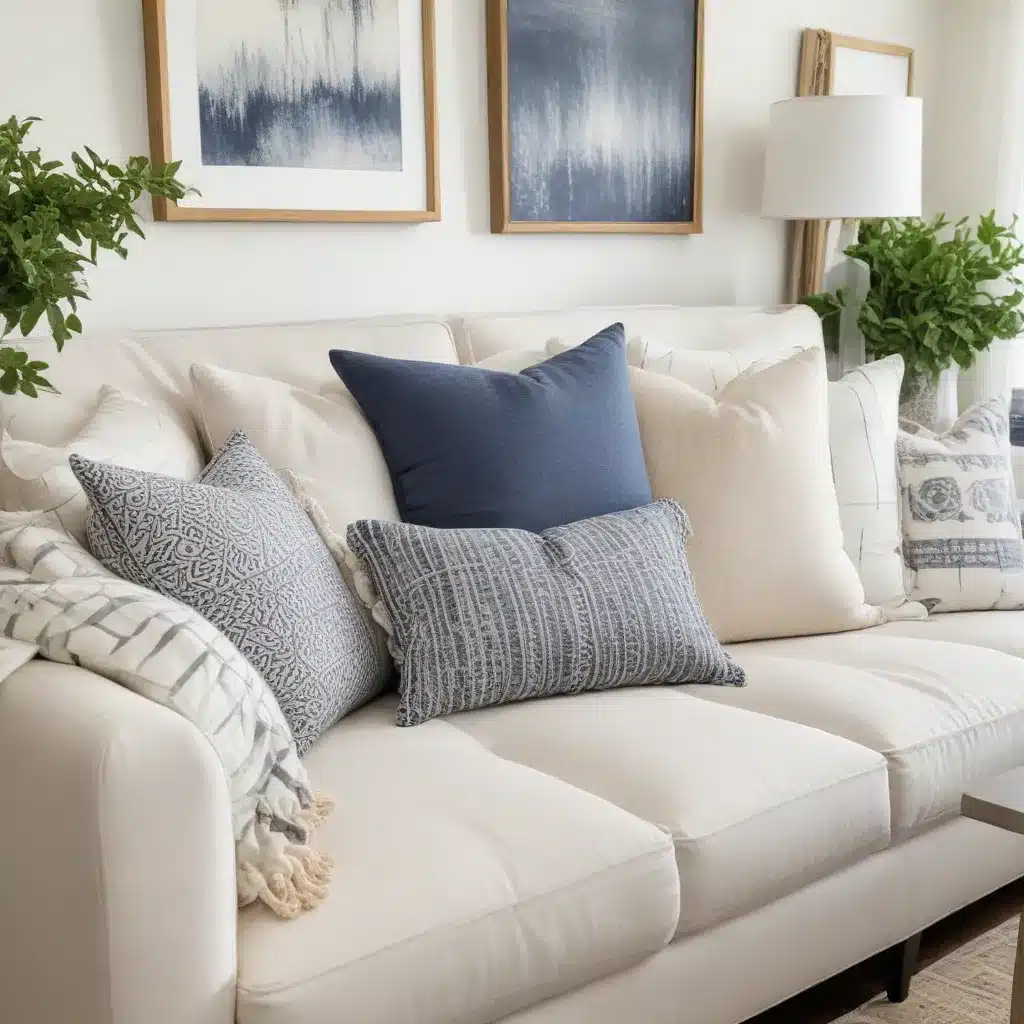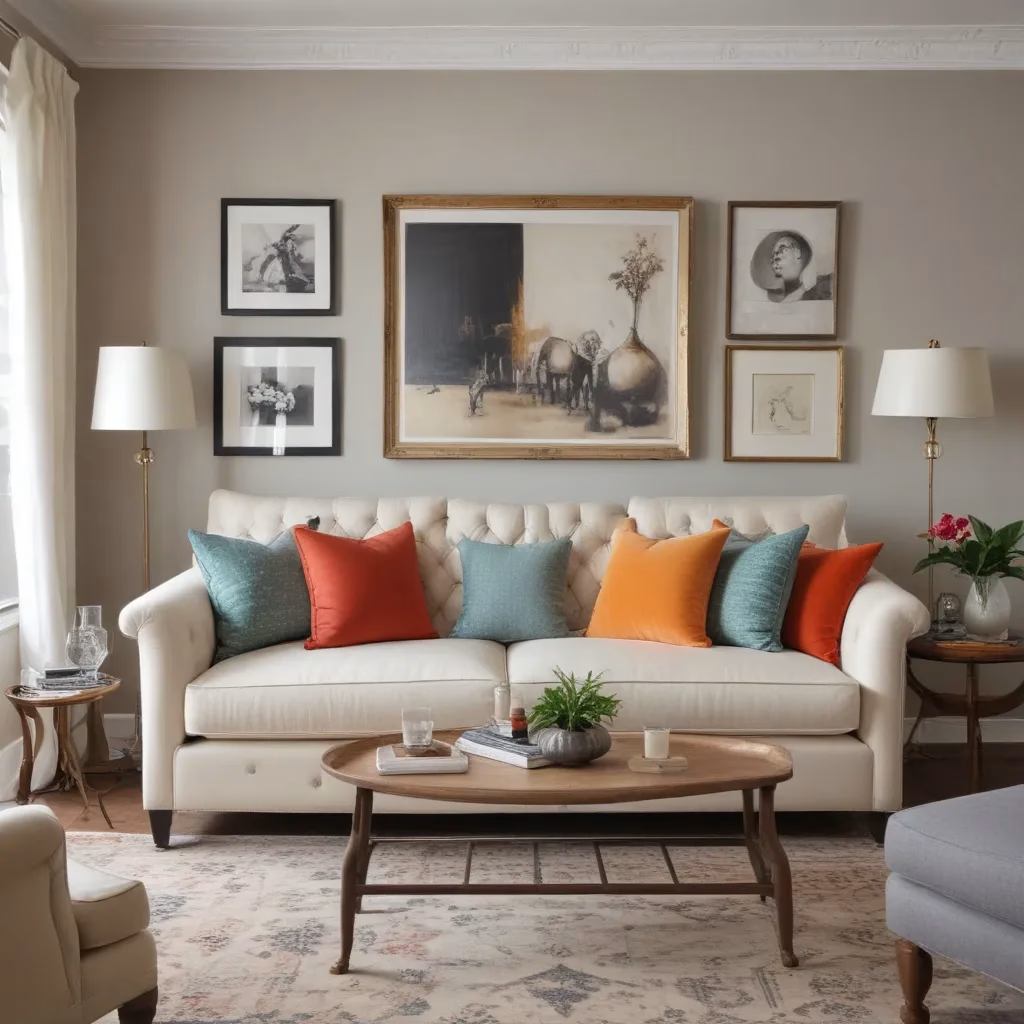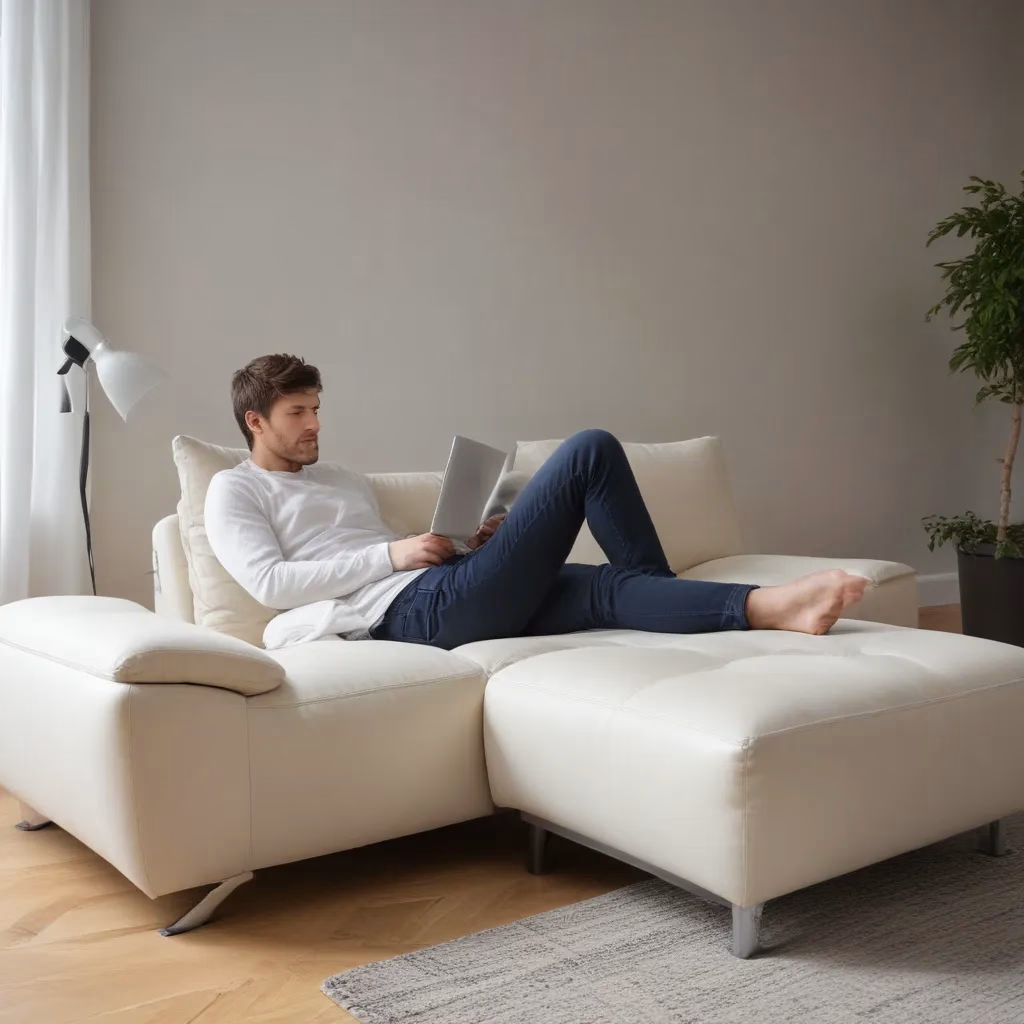
The Art of Sofa Accessorizing
As a furniture specialist with years of experience, I’ve seen firsthand how the right combination of pillows and throws can transform a sofa from a simple seating option to the centerpiece of a living room. It’s not just about tossing a few cushions onto your couch; there’s a subtle art to creating a look that’s both visually appealing and comfortable.
When I first started in this industry, I made plenty of mistakes. I’d overload sofas with mismatched pillows or choose throws that clashed horribly with the upholstery. But over time, I’ve developed a keen eye for what works and what doesn’t. I’ve learned that the key to successful sofa styling lies in understanding the principles of color, texture, and proportion.
Let me share with you some of the insights I’ve gained over the years. Whether you’re a homeowner looking to refresh your living space or an aspiring interior designer, these tips will help you create a sofa arrangement that’s both beautiful and functional.
Understanding the Basics of Pillow Arrangements
When it comes to arranging pillows on a sofa, there’s no one-size-fits-all approach. However, there are some fundamental guidelines that I always keep in mind.
First and foremost, consider the size of your sofa. A large sectional can handle more pillows than a compact loveseat. As a general rule, I like to start with larger pillows at the back and work my way forward with smaller ones. This creates depth and allows for comfortable leaning.
For a standard three-seater sofa, I typically recommend using five to seven pillows. This might sound like a lot, but when arranged correctly, it creates a luxurious, inviting look without overwhelming the space.
Remember, odd numbers often work best in design. A grouping of three or five pillows tends to look more natural and less staged than an even number. This is a trick I’ve used countless times to create a perfectly imperfect look.
Choosing the Right Pillow Sizes
Selecting the appropriate pillow sizes is crucial for achieving a balanced look. In my experience, a mix of sizes creates visual interest and allows for versatility in styling.
For the back row of pillows, I often opt for larger sizes, typically 22 to 24 inches square. These provide a solid foundation and offer great back support for anyone sitting on the sofa. In front of these, I’ll place slightly smaller pillows, usually around 20 inches square.
To add some variety, I love incorporating lumbar pillows. These rectangular cushions, often measuring about 12 by 20 inches, can serve as a nice accent piece and provide extra lower back support. They’re especially great for breaking up the monotony of square pillows.
Here’s a quick reference table I often use when selecting pillow sizes:
| Position | Size Range |
|---|---|
| Back | 22-24 inches square |
| Middle | 20-22 inches square |
| Front | 18-20 inches square or lumbar (12×20 inches) |
The Importance of Color Coordination
Choosing the right color palette for your sofa pillows and throws can make or break your overall design. I always advise my clients to start by considering the color of their sofa and the existing color scheme in the room.
If you have a neutral-colored sofa, you have the freedom to experiment with bolder, more vibrant pillow colors. On the other hand, if your sofa is already a statement piece with a strong color or pattern, you might want to choose pillows in complementary or neutral tones.
One technique I often use is the 60-30-10 rule. This means 60% of your color scheme should be a dominant color (often the color of your sofa), 30% should be a secondary color, and 10% should be an accent color. This creates a balanced and harmonious look.
For example, if you have a navy blue sofa, you might choose pillows that are predominantly light blue or gray (your 30%), with a pop of yellow or coral as your accent (the 10%). This creates a cohesive look while still adding visual interest.
Mixing Patterns and Textures
One of my favorite aspects of sofa styling is playing with different patterns and textures. This is where you can really let your creativity shine and add personality to your space.
When mixing patterns, I always suggest starting with a larger pattern, then adding in medium and small-scale patterns. This creates a sense of balance and prevents the arrangement from looking too busy. For instance, you might start with a large floral print, add in a medium-sized geometric pattern, and finish with a small polka dot or stripe.
Texture is equally important. I love combining different materials to create a rich, layered look. Think about mixing smooth silks with nubby wools, or sleek velvets with rough linens. This not only adds visual interest but also creates a tactile experience that makes your sofa more inviting.
Remember, though, that there is such a thing as too much variety. I always advise my clients to limit themselves to three or four different patterns or textures to avoid overwhelming the eye.
The Role of Throw Blankets
Throw blankets are the unsung heroes of sofa styling. They add warmth, both literally and visually, and can tie your whole look together.
When choosing a throw, consider both its aesthetic appeal and its functionality. I always recommend opting for a throw that’s soft and cozy – after all, it’s meant to be used, not just looked at. Materials like cashmere, wool, or high-quality cotton are excellent choices.
In terms of styling, there are several ways to incorporate a throw blanket. You can drape it casually over one arm of the sofa for a relaxed look, fold it neatly and place it at one end, or even drape it diagonally across the back of the sofa. The key is to make it look effortless, even if you’ve spent time getting it just right.
Color-wise, your throw can either complement your pillow arrangement or provide a contrasting pop of color. I often use throws as a way to introduce a new color or pattern into the mix, especially if I’ve kept the pillows relatively neutral.
Seasonal Styling Tips
One of the joys of sofa styling is the ability to easily update your look with the changing seasons. Over the years, I’ve developed a few go-to strategies for each season that I’m excited to share with you.
For spring, I love to brighten things up with fresh, light colors. Pastel pillows in shades of mint green, soft pink, or pale yellow can breathe new life into your space. I often pair these with throws in light, breathable fabrics like cotton or linen.
Summer calls for a more relaxed, breezy feel. I tend to reduce the number of pillows slightly and opt for lighter fabrics. Natural textures like jute or sisal can add an organic, beachy vibe. Cool blues and crisp whites are always a hit in the warmer months.
As autumn rolls around, I start incorporating warmer, richer tones. Deep oranges, burgundies, and forest greens can create a cozy atmosphere. This is also a great time to introduce heavier textures like wool or velvet.
Winter is all about creating a warm, inviting space to curl up in. I love using plush, fuzzy pillows and thick, chunky knit throws. Deep jewel tones or classic winter whites can create a sophisticated, seasonal look.
Remember, you don’t need to completely overhaul your pillow collection each season. Often, swapping out just a few key pieces can make a big difference.
Practical Considerations for Everyday Use
While aesthetic appeal is important, it’s crucial not to forget about practicality. After all, sofas are meant to be used, not just admired from afar.
One question I often get from clients is how to keep their beautifully styled sofa looking good when it’s being used daily. My advice is always to strike a balance between style and function.
Firstly, consider the fabric of your pillows and throws. If you have kids or pets, opt for durable, easy-to-clean materials. Many modern fabrics are designed to be stain-resistant and machine washable, which can be a lifesaver.
Secondly, don’t go overboard with the number of pillows. While a mountain of cushions might look great in a photoshoot, it’s not practical for everyday life. I usually recommend having a couple of larger pillows for back support, and then 2-3 smaller decorative pillows that can be easily moved when someone wants to sit down.
Lastly, have a plan for storage. A nearby basket or ottoman can be a great place to store extra pillows or throws when they’re not in use. This allows you to change up your look easily and keeps your sofa from becoming cluttered.
The Impact of Sofa Style on Pillow Arrangements
It’s important to remember that the style of your sofa should inform your pillow arrangement. Different sofa styles call for different approaches to accessorizing.
For a modern, minimalist sofa, less is often more. I might use just two or three large pillows in solid colors or with subtle patterns. The focus here is on clean lines and a streamlined look.
On the other hand, a traditional Chesterfield sofa can handle a more elaborate arrangement. The deep buttoning and rolled arms provide a perfect backdrop for a mix of patterns and textures. I love creating a layered look with multiple pillows of varying sizes.
For a mid-century modern piece, I often opt for geometric patterns and bold colors that complement the sofa’s sleek lines. A couple of square pillows paired with a lumbar pillow can create a look that’s both stylish and true to the era.
Sectional sofas present their own unique challenges and opportunities. With more space to work with, you can create distinct groupings of pillows. I might use one arrangement on the main section and a different, complementary grouping on the chaise.
Common Mistakes to Avoid
Over the years, I’ve seen (and, admittedly, made) my fair share of sofa styling mistakes. Here are a few common pitfalls to watch out for:
Overcrowding: It’s easy to get carried away and add too many pillows. This not only looks cluttered but can also make your sofa uncomfortable to sit on. Remember, less is often more.
Ignoring scale: Using pillows that are too small for your sofa can make them look lost and insignificant. Conversely, pillows that are too large can overwhelm the space.
Matching everything: While coordination is important, having everything match perfectly can look stiff and uninspired. Don’t be afraid to mix things up a bit.
Neglecting texture: Using pillows and throws all made from the same material can make your arrangement fall flat. Mixing textures adds depth and interest to your styling.
Forgetting about functionality: Beautiful pillows are great, but if they’re not comfortable or practical, they’ll likely end up on the floor more often than not.
By avoiding these common mistakes, you’ll be well on your way to creating a sofa arrangement that’s both beautiful and functional.
The Finishing Touches
As we wrap up our exploration of sofa styling, let’s talk about those final details that can really elevate your arrangement.
One element I always pay attention to is the pillow inserts. High-quality inserts can make a world of difference in how your pillows look and feel. For a luxurious, full look, I often recommend using inserts that are slightly larger than the pillow cover.
Don’t forget about the power of embellishments. Tassels, fringe, or decorative buttons can add a touch of personality to your pillows. Just be careful not to go overboard – one or two embellished pillows mixed with simpler ones usually works best.
Lastly, consider the overall balance of your arrangement. Step back and look at your sofa as part of the whole room. Does it complement the other furnishings? Does it contribute to the overall style you’re aiming for?
Remember, sofa styling is as much an art as it is a science. Don’t be afraid to experiment and trust your instincts. With practice and attention to detail, you’ll soon be creating sofa arrangements that are both beautiful and uniquely you.
For more inspiration and expert advice on all things furniture-related, be sure to check out our website at Sofa Spectacular. Happy styling!



